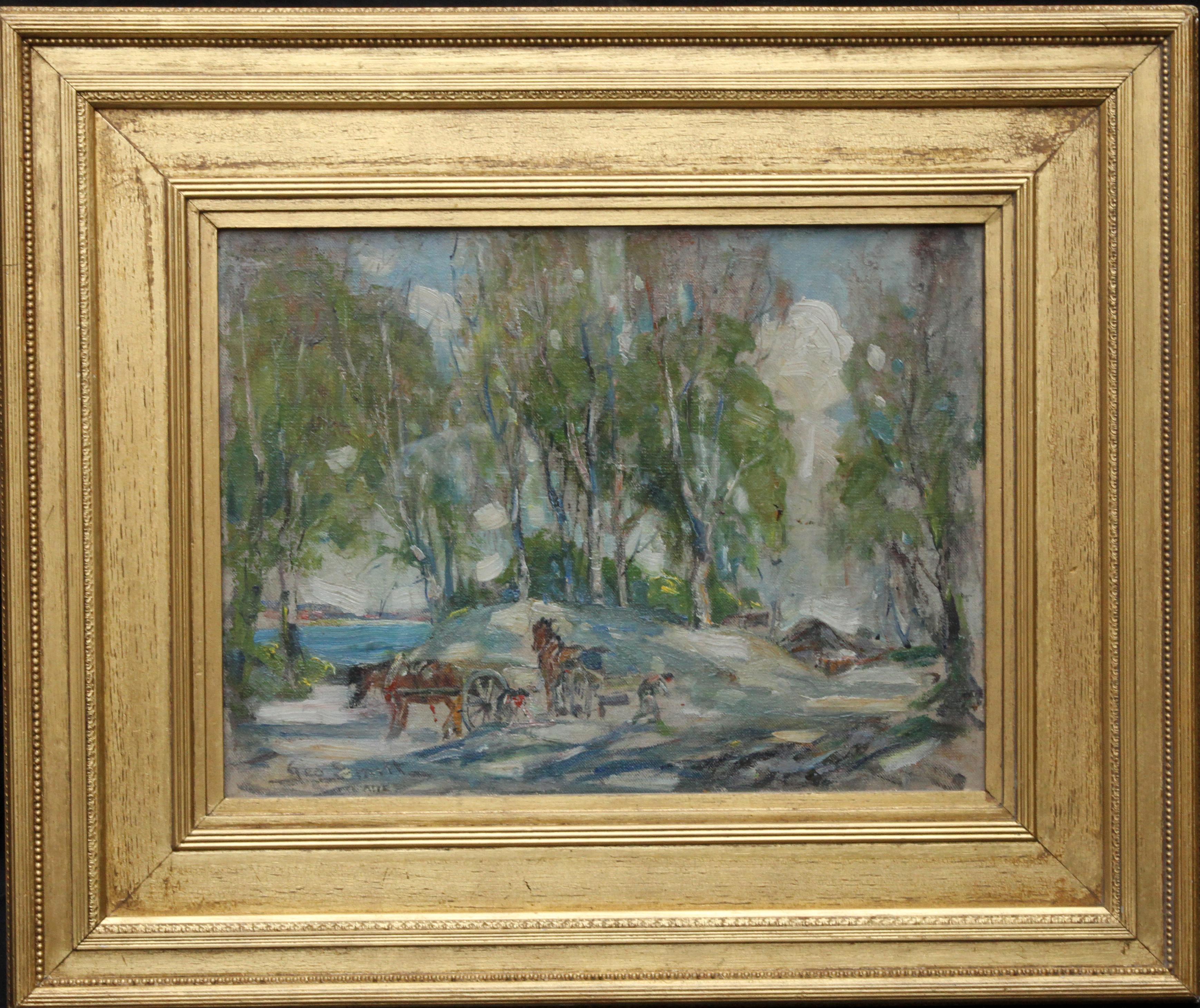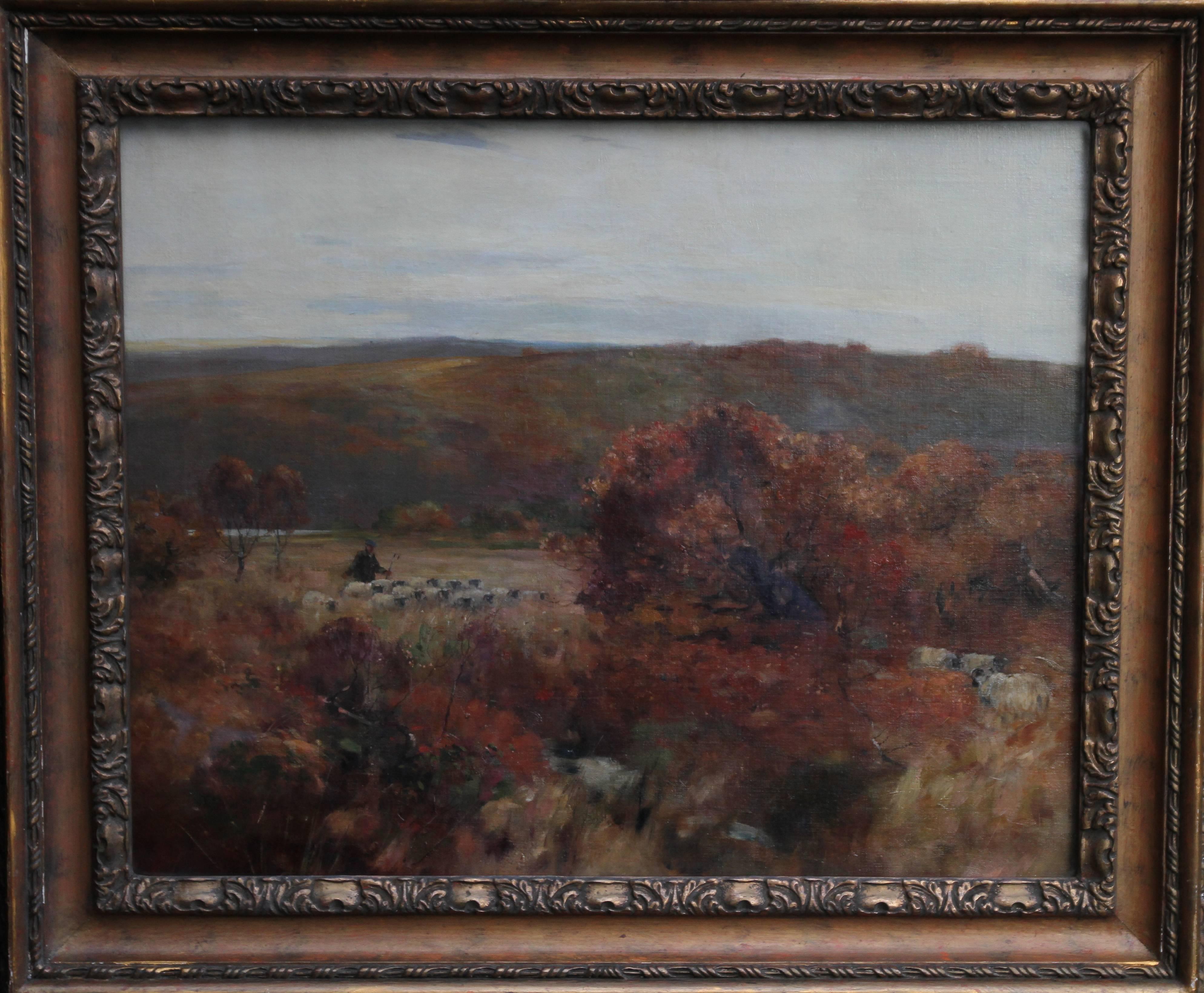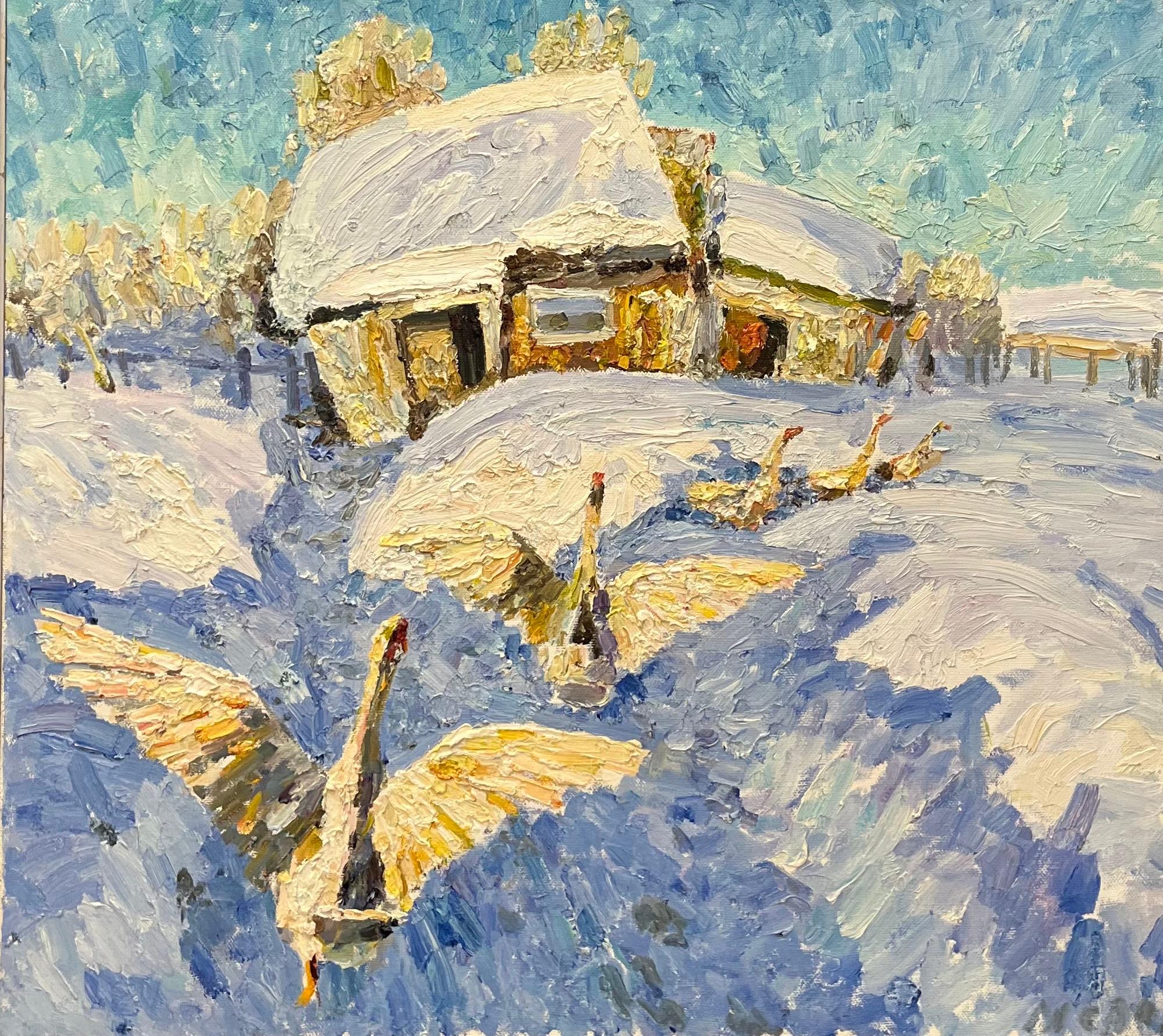George HenryChanctonbury Ring - Scottish Glasgow Boy art RA exh 1933 landscape oil painting1932
1932
About the Item
- Creator:George Henry (1858 - 1943, Scottish)
- Creation Year:1932
- Dimensions:Height: 47 in (119.38 cm)Width: 57 in (144.78 cm)Depth: 2 in (5.08 cm)
- Medium:
- Movement & Style:
- Period:
- Condition:
- Gallery Location:London, GB
- Reference Number:1stDibs: LU853113343362
George Henry
George Henry was a Scottish painter and one of the most prominent of the Glasgow School. He was born in Irvine, North Ayrshire, and studied at the Glasgow School of Art, later in Macgregor's studio, but learned most from his nature studies at Kirkcudbright. His father's name was Hendry and George dropped the "d" from his surname as a young man. Henry was influenced also by his collaboration with E. A. Hornel in such works as The Druids (1887), Grosvenor Gallery, London. His Galloway Landscape was epoch-making at Glasgow because of its higher key of color and essentially decorative character. Following these tendencies, the two friends spent a year and a half in Japan. Henry's importance consists in his influence in the Glasgow school in the direction of richer and more decorative color. In addition to genre and landscape, he also painted portraits, more distinguished by technical ability than by rendition of the character. Henry's pictures in public collections include The Blue Gown, Museum of Cape Town, The Gray Hat, at Edinburgh, two portraits at Glasgow, and one at Montreal. He was elected a member of the Royal Scottish Academy (1902) and an associate of the Royal Academy. The Black Hat, a luminous portrait of a supremely confident Edwardian woman, was recently included in Modern Britain, an exhibition at Melbourne's National Gallery of Victoria.
- ShippingRetrieving quote...Ships From: London, United Kingdom
- Return PolicyA return for this item may be initiated within 14 days of delivery.
- Pastoral Landscape - Scottish art 1900 Impressionist landscape oil paintingBy David FultonLocated in London, GBThis lovely Scottish Impressionist landscape oil painting is by noted artist David Fulton RWS. Painted circa 1900 it is a pastoral landscape depicting a shepherd and his flock in a l...Category
Early 1900s Impressionist Landscape Paintings
MaterialsOil
- Landscape with Sheep - Scottish 1920 Impressionist art landscape oil paintingBy William PrattLocated in London, GBThis gorgeous, vibrant Scottish Impressionist landscape oil painting is by noted Glasgow artist William Pratt. Painted in 1920 the composition is sheep, shepherd and sheepdog in the...Category
1920s Impressionist Landscape Paintings
MaterialsOil
- Working Horses in Scottish Landscape - Scottish 1920s art Impressionist paintingBy George SmithLocated in London, GBThis lovely Impressionist Colourist oil painting is a fine example of the work of noted Scottish landscape and animal artist George Smith. He was particularly known for his paintings...Category
1920s Impressionist Animal Paintings
MaterialsOil
- Landscape with Cattle and Sheep - British Victorian art Pastoral oil paintingBy William Mark FisherLocated in London, GBThis lovely British Victorian Impressionist pastoral landscape oil painting is by prolific exhibitor William Mark Fisher. Known as a B...Category
19th Century Impressionist Landscape Paintings
MaterialsOil
- Watering Horses - British Edwardian Impressionist art oil painting female artistBy Rowley LeggettLocated in London, GBA stunning Edwardian oil on canvas by female artist Rowley Leggett who was a Surrey based artist. She was a noted rustic landscape painter and specialised in these sort of landscape...Category
1910s Impressionist Animal Paintings
MaterialsOil
- Portrait of Horses in Dappled Sunlight - British 30's Impressionist oil paintingBy Arthur SpoonerLocated in London, GBThis beautiful British Impressionist oil painting is by noted animal artist Arthur Spooner. Painted circa 1935 it is a superb painting of two working horses standing in the shade of ...Category
Early 20th Century Impressionist Animal Paintings
MaterialsOil
- "Moving the Wild Ones", Robert Hagan, 60x216, Oil/Canvas, Western, ImpressionismLocated in Dallas, TX"Moving the Wild Ones" by Robert Hagan is an original oil on canvas and measures 60x216. In this large original painting by Robert Hagan, cowboys on horseback run through the canyon mountains kicking up dust and trying to reign in runaway mustangs and they travel through the blue water and canyons. The contemporary cowboys are in trench coats with their cowboy hats flying off into the sky while holding Mustang Australian-style bullwhips that are ready to strike. Translating scenes of everyday life into nostalgic and blissfully peaceful visions of the world, Robert Hagan has become a premier Western artist of our time. A man of many talents his impressionistic style using a limited palette of oil brings a sense of tranquility that makes his paintings come alive. Robert Hagan is an Australian painter...Category
2010s Impressionist Landscape Paintings
MaterialsCanvas, Oil
- "Geese in the snow" oil cm. 100 x 80By Georgij MorozLocated in Torino, ITSnow, geese,white,Ukraine Georgij MOROZ (Dneprodzerzinsk, Ucraina, 1937 - St. Petersburg, 2015) 1937: he was born in Dneprodzerzinsk, Ucraina. 1949-56: he began artistic studies in ...Category
Early 2000s Impressionist Animal Paintings
MaterialsCanvas, Oil
- Motherlove, Constant Artz, Oil paint/canvas, ImpressionismLocated in OOSTERBEEK, NLNetherlands, 1870-1951 Constant Artz is the painter of the well-known extremely friendly and sunny scenes with a duck with young ones on the side of a ditch. He was born in Paris in...Category
19th Century Impressionist Animal Paintings
MaterialsOil, Canvas
- Franklin White, British Australian Impressionist view of English country cottageBy Franklin WhiteLocated in Harkstead, GBA wonderful image of an English country cottage set in a meadow with cattle grazing. Franklin White (1892-1975) A cottage in the countryside Signed with initials and dated (19)32 Oi...Category
Mid-20th Century Impressionist Landscape Paintings
MaterialsCanvas, Oil, Board
- Harry Fidler, Impressionist study of a working Horse in farmyardBy Harry FidlerLocated in Harkstead, GBA super example of Harry Fidler's impressionist studies with characteristic use of heavy impasto. The flamboyant sculpting of the paint surface cannot be fully conveyed in a 2D image...Category
Early 20th Century Impressionist Landscape Paintings
MaterialsCanvas, Oil
- British impressionist Springtime with blossom in the English countrysideLocated in Harkstead, GBA really appealing view of the English countryside in the springtime with rolling hills, cattle grazing in lush pasture and a windmill off in the distance. George Graham (1881-1949)...Category
Mid-20th Century Impressionist Animal Paintings
MaterialsBoard, Canvas, Oil






